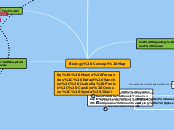Biology Concept Map
Test 2
Cell Signaling Pathways and Cancer
Phospholipids
Carbohydrates
glycoproteins
glycolipids
Proteins
Peripheral
loosely bound to membrane
Golgi bundles the vesicles and the vesic;es spill contents out of the plasma membrane
Test 1
Covalent bond
Chemical Bonding
Water and its properties
Organic Molecules
Energy, Cellular Respiration, Photosynthesis
Substrates
Metabolism
Energy
Respiration
Photosynthesis
Organelles
Chloroplast
Mitochondria
DNA Within Nucleus
Peroxisome
Cytoplasm
No Membrane Enclosed Organelles
DNA in nucleoid
Endosymbiotic theory
DNA Replication
starts w/ ORI at DNA
Single Strand Binding Protein
1.Helicase
Unwinds DNA
2. Primase adds RNA nucleotides
multiple primase for lagging strand
3. Primase
adds RNA nucleotides one at a time
makes short segment of RNA
4. DNA Pol I
Synthesize new DNA by adding of nucleotides (5 to 3 direction)
Has proofreading abilities (3 to 5 direction)
5. DNA Pol III
Leading Strand: synthesizes a complimentary strand continuously by elongating new DNA. (5 to 3 direction)
Lagging Strand: elongate new strand in 5 to 3 direction. Works away from replication fork.
6. DNA Ligase
Helps form phosphodiester bonds between DNA
Topoisomerase
Helps reduce tension between ends of uncoiled DNA
DNA Transcription
DNA to RNA
Prokaryotes: RNA Pol I
Eukaryotes: RNA Polymerase II
Makes: Pre-mRNA
No terminator sequence
RNA Splicing
Exons: stay in mRNA
Introns: spliced out
Makes: mRNA
No Splicing
Has terminator sequence
DNA Translation
mRNA
Tonicity
Hypertonic
Plants
Animals
Hypotonic
Isotonic
Phospholipid bilayer
Unsaturated tails
Steroid Cholesterol
Cell-Cell Recognition
Cell Signaling Pathways
Eukaryotes
G-Protein Signaling
hormone binds to receptor
receptor changes shape (receptor activated)
G-Protein activated
G-Protein binds to receptor
GDP ---> GTP
hormone leaves receptor
Adenylyl Cylclase activated
ATP -->cAMP
Adenylyl Cyclase inactivated
cAMP bind to Protein Kinase A
phosphorylation cascade
Protein Kinase A = enzyme
GTP---> GDP
GTPase
Adenylyl Cyclase= enzyme
Cancer
oncogenes
cancerous genes
proto-oncogenes
normal genes that stimulate normal cell growth/division
RAS
Characterisitics of cancer cells
loss of density dependent inhibition
loss of anchorage dependence
accumulation of mutants
ability to invade/disrupt distant and local tissues
Tumor-suppressor genes
encode proteins that inhibit abnormal division of cells
mutation: p53
BRCA 1 and BRCA 2
breast and other tissue
help repair damaged DNA
phosphodiester bonds
Transmembrane proteins
Passive Transport
Channel Proteins
aquaporins
Diffusion
High conc to Low Conc
Osmosis
Lactose
Operon
Prokaryotes
Carrier Proteins
Sodium-Potassium Pump
Exchanges NA+ with K+
Ion channels
Tryptophan
Operon
repressor= inactive; tryptophan (co-repressor) needed to bind to operator
Facilitated Diffusion
Ion Channels
Gated
open/close in response to stimuli
Not gated
open/close in response to shift in voltage
Membrane potential
Negative inside of membrane
Cations in
Anions out
Electrochemical grandient
Electrogenic pump
Proton Pump
Cotransport
H+/Sucrose Pump
Positive outside of membrane
Cell Cycle
Interphase
G1: Cell prepares to duplicate
S: Chromosomes duplicated (46)
G2: Cell checked for errors
Sister chromatids form
ATP produced
Action Potential
Constant magnitude
Resting State
Depolarization
Rising Phase
Falling Phase
Undershoot
Synapses
Chemical Synapses
relies on pre-synaptic neuron to release neurotranmitter
increase in Ca+ causes vesicles to fuse w/ pre-synaptic membrrance
Electrical Synapses
gap junctions
enable direct flow from neuron to neuron
Hydrogen bonds
strong dipole dipole interactions
EX: water molecule connections
when hydrogen atoms are covalently bonded to electronegative atom
heat absorbed hydrogen bonds break, heat released when they reform
Adhesion
Cohesion
Van der Waals
when atoms are close, weak interactions
non-polar bonds have + and - charges regions
electrons not evenly distributed causing them yo stick together
Biological molecules
Carbohydrates
Lipids
Proteins
Nucleic Acids
Polymerase Chain Reaction (PCR)
Ribosomes
rRNA
Integral
embedded into membrane
Translocation
ER signal
1. Signal Recognition Protein (SRP) attaches and pauses
2. goes to ER and SRP comes off
3. Signal peptidase cuts protein
4. Glycosylation: adding sugar groups to protein
Vesicles
Transport to Golgi
Can go to back to ER or Lysosomes
Extracellular membrane
depart of membrane
Secrete out
Mutations
Types of Mutations
Bulk Transport
Active Transport
Moves solute against conc. gradient
Process of selectively amplifying a piece of DNA
Step 1: Denaturation (helicase)
Step 2: Annealing (attach)
Step 3: Elongation
Exocytosis
Endocytosis
phagocytosis
pinocytosis
receptor-mediated endocytosis
Linkage of nucleotides
Involves dehydration reaction
in RNA, Adenine (A) pairs w/ Uracil (U) and Thymine is not present.
DNA Packaging
Nucleosome
Mitosis
Makes 2 daughter cells
diploid 2n=46
2n
2n
Meiosis 1 (haploid n=23)
Meiosis 2
Mitosis
Phases
Prophase: Chromosomes condense,
mitotic spindle forms, nucleolus disappears
Prometaphase: nuclear envelope
releases releases condensed chromosomes,
Gene Regulation
Proximal control elements
Transcription Factors
Distal control elements
Cyclin dictates the target protein to phosphorylate by the CDK
Cell Cycle Regulators
Cyclin
Structurally and functionally related proteins
CDK (Cyclin-dependent kinases)
structurally and functionally related proteins
Kinases: add phosphate to target proteins
Hyperpolarization
Refractory period
Meiosis
Makes 4 daughter cells
Starts diploid (2n=46)
n=23
n
n
n=23
n
n
Evolution in Prokaryotic Cells
Oparin's Bubble Hypothesis
Identified Hydrogen cyanide, formaldehyde, amino acids, hydrocarbons within primitive atmosphere.
Abiotic synthesis of proteins
Primitive proteins
Abiotic synthesis of DNA, RNA
Primitive DNA, RNA
Protocell
DNA Structure & Replication Experiments
Griffith Experiment
Smooth bacteria injected in mice killed mice
Smooth with rough bacteria did NOT kill mice
Smooth heat killed bacteria did NOT kill mice
Smooth heat killed bacteria with rough killed mice
Hershey-Chase
radioactive sulfur within bacteriophage protein did not go inside bacterial cell
radioactive phosphorous within bacteriophage DNA did go inside bacterial cell.
Messleson and Stahl
Proved Conservative and Dispersive model was not accurate to how DNA replication worked.
Proved that Semiconservative model was accurate to how DNA replication worked.
